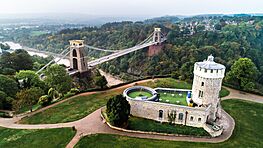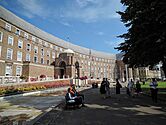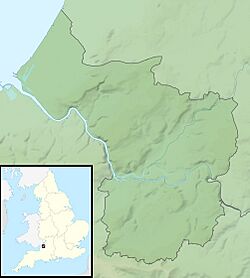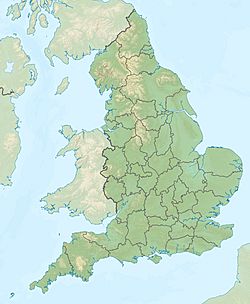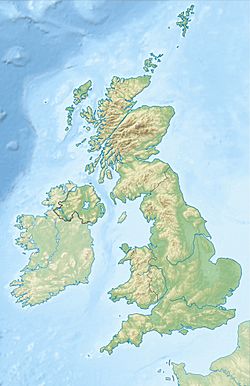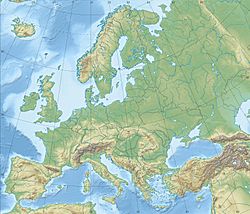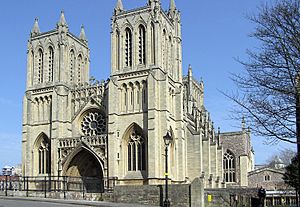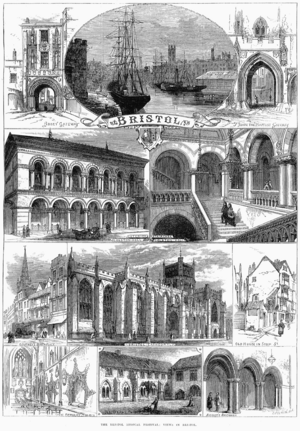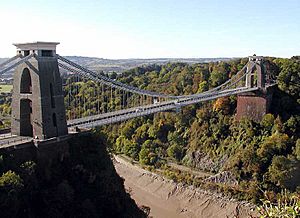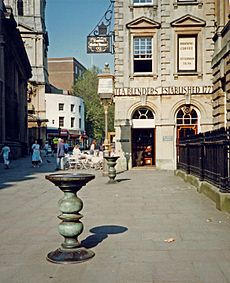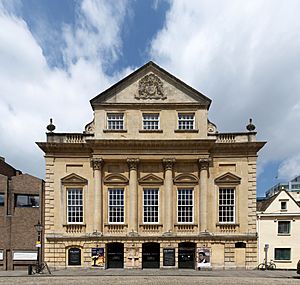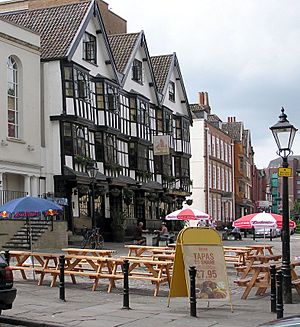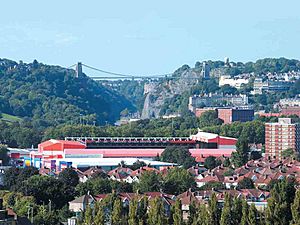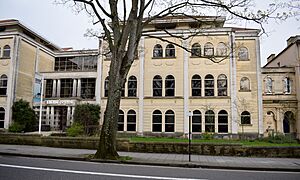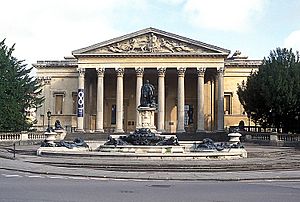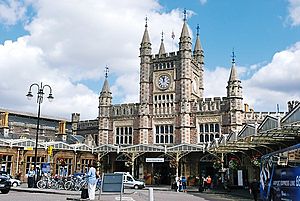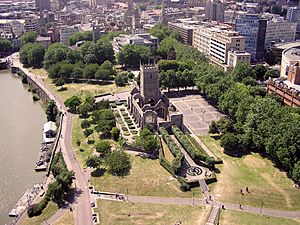Bristol facts for kids
Quick facts for kids
Bristol
|
|
|---|---|
| Motto(s):
Virtute et industria
(With courage and industry) |
|
| Sovereign state | United Kingdom |
| Country | England |
| Region | South West |
| Royal charter | 1155 |
| County corporate | 1373 |
| City status by diocese creation | 1542 |
| Ceremonial county | 1996 |
| Status | City, county and unitary authority |
| Government | |
| • Type | Unitary authority |
| Area | |
| • City and county | 40 sq mi (110 km2) |
| Elevation | 36 ft (11 m) |
| Population
(2021)
|
|
| • City and county | 472,500 (Ranked 10th district and 43rd ceremonial county) |
| • Density | 11,000/sq mi (4,248/km2) |
| • Urban | 707,412 |
| Demonym(s) | Bristolian |
| Ethnicity (2021) | |
| • Ethnic groups |
List
|
| Religion (2021) | |
| • Religion |
List
51.4% no religion
32.2% Christianity 9.7% other 6.7% Islam |
| Time zone | GMT (UTC) |
| • Summer (DST) | UTC+1 (BST) |
| Postcode |
BS
|
| Area codes | 0117, 01275, 01454 |
| ISO 3166 code | GB-BST |
| GVA | 2017 |
| • Total | £21.2bn (.9bn) (4th) |
| • Growth | |
| • Per capita | £33,700 (,800) (4th) |
| • Growth | |
| Click the map for an interactive fullscreen view | |
Bristol (pronounced BRISS-tull) is a big city in the South West of England. It is built around the River Avon. Bristol is a special type of city called a unitary authority, which means it has its own local government. It is also a ceremonial county.
For a long time, Bristol was one of England's most important cities. It was a major port where ships sailed to explore new lands. Today, Bristol is known for its creative industries, electronics, and aerospace (things to do with planes and space). The old docks in the city centre have been made into fun places with shops and museums.
Bristol has many cool places for art and sports. It has two universities: the University of Bristol and the University of the West of England. You can fly to Bristol from Bristol Airport. You can also get there by train or car. In 2014 and 2017, Bristol was named the best city to live in Britain. It also won the European Green Capital Award in 2015.
Contents
- What's in a Name?
- Bristol's Story
- Where is Bristol?
- People of Bristol
- Bristol's Economy
- Bristol's Culture
- Sports in Bristol
- Bristolian Dialect
- Religions in Bristol
- Nightlife and Fun
- Media in Bristol
- Learning in Bristol
- Getting Around Bristol
- Bristol's International Friends
- Famous Bristolians
- Images for kids
- See also
What's in a Name?
The name "Bristol" comes from an old English word, Brycgstow. This means 'place at the bridge'. Some people think it meant "the place called Bridge by the place called Stow." Stow might have been an early religious meeting spot. The name used to be Bricstow until about 1204. Over time, the local way of speaking, called the Bristolian 'L', added an "L" sound to words ending in a vowel. This changed the name to Bristol.
Bristol's Story
Early Days
People have lived in the Bristol area for a very long time. Tools found here show that Neanderthals were around between 300,000 and 126,000 years ago. Later, during the Iron Age, people built hill forts near the Avon Gorge. The Romans also had settlements nearby, like Abona at what is now Sea Mills.
Medieval Bristol
Bristol was founded by the year 1000. By 1020, it was a busy trading centre with its own mint making silver coins. After the Normans took over England, Bristol had one of the strongest castles in the south. The city's port grew around the Rivers Frome and Avon. By the 12th century, Bristol was a very important port, trading a lot with Ireland.
In 1373, Bristol became a "county corporate." This meant it was a special town that governed itself, separate from the surrounding counties. It was the first town in England to get this status. Bristol also became a place where ships were built and goods were made. By the 14th century, Bristol was one of England's largest towns, after London. However, many people died during the Black Death in 1348–49.
Exploration and Trade
In the 15th century, Bristol was England's second most important port. It traded with places like Ireland, Iceland, and France. Many voyages of exploration started from Bristol. In 1497, John Cabot sailed from Bristol and landed in North America. Another Bristol merchant, William Weston, led the first English expedition to North America in 1499. Bristol merchants even formed a company to help with these new explorations.
In the 16th century, Bristol merchants focused on trading with Spain and its American colonies. This included secretly trading goods like food and guns during wars. Bristol's secret trade grew a lot after 1558 and became a big part of its economy.
In 1542, the Diocese of Bristol was created. This is when the old Abbey of St. Augustine became Bristol Cathedral. Bristol also officially became a city that year. During the English Civil War in the 1640s, the city was taken over by Royalists.
A Growing Port
As England started to build colonies in the Americas in the 17th century, Bristol grew even more. Its location on the west coast of Great Britain was perfect for ships sailing to the New World. In the 18th century, Bristol became a major centre for the trade of people from Africa to the Americas. This was part of a "triangular trade" route. Goods were sent to Africa, people were taken from Africa to the Americas, and then goods like sugar and tobacco came back to England.
From 1700 to 1807, over 2,000 ships from Bristol carried an estimated 500,000 people from Africa to be enslaved in the Americas. The Somersett Case in 1772 made it clear that slavery was against the law in England. The Seven Stars pub, where abolitionist Thomas Clarkson gathered information about the slave trade, is still open today.
In 1739, John Wesley started the first Methodist chapel in Bristol, called the New Room. He preached to large crowds, often outdoors.
Victorian Era and Beyond
The city is linked to the famous Victorian engineer Isambard Kingdom Brunel. He designed the Great Western Railway from Bristol to London. He also designed two important steamships, the SS Great Britain and SS Great Western. And of course, he designed the famous Clifton Suspension Bridge.
By 1867, ships were getting bigger. The twists and turns of the River Avon made it hard for large boats to reach Bristol Harbour. So, the port facilities moved downstream to Avonmouth and later to Royal Portbury Dock. This led to some traditional industries declining. However, the import and processing of tobacco grew with the W.D. & H.O. Wills company.
Bristol's population grew a lot in the 19th century, from 66,000 in 1801 to five times that size. This led to new areas like Clifton and Cotham being built. These areas show beautiful Georgian and Regency style buildings.
20th Century and Modern Bristol
Bristol continued to grow in the 20th century. Its docks were made bigger, and new ones were built. As air travel became popular, aircraft factories were built in areas like Filton.
Bristol was badly damaged by bombs during World War II. About 1,300 people died, and nearly 100,000 buildings were damaged. The old central market area is now a park with two bombed churches. One church, St Nicholas, has been rebuilt and is now a museum.
After the war, the city centre was rebuilt with new buildings and roads. Later, some main roads were closed, and historic squares like Queen Square were restored. The M4 and M5 motorways were built in the 1960s and 70s. These motorways connect Bristol to London, Swansea, Exeter, and Birmingham.
Because the main docks moved away from the city centre, the old Floating Harbour area could be redeveloped. It is now a popular place for fun and relaxation.
Where is Bristol?
Bristol is part of a limestone area that stretches from the Mendip Hills to the Cotswolds. The Rivers Avon and Frome cut through this limestone, creating Bristol's hilly landscape. The Avon flows from Bath through flat areas and then through the Avon Gorge to the west.
The Avon Gorge helped protect Bristol Harbour. Its land is now protected as The Downs and Leigh Woods. The Avon river flows into the Severn Estuary at Avonmouth.
Bristol's Weather
Bristol is in southern England, so it's one of the warmer cities in the UK. It gets a lot of sunshine, usually between 1,541 and 1,885 hours a year. The Atlantic Ocean affects Bristol's weather, keeping temperatures above freezing all year. But it does get frosts in winter, and sometimes snow falls. Summers are warm and usually drier.
People of Bristol
Bristol is a diverse city. According to the 2011 census, most people (84%) were White. There are also significant Asian, Black, and mixed-race communities. Bristol is unique among large British cities because it has a larger Black population than Asian population.
The city's population has grown a lot over the centuries. In 1801, about 66,000 people lived here. By 1971, it reached its peak at 428,089. In 2021, the population was 472,500.
Bristol's Economy
Bristol has always been a city of trade. In the past, it exported wool and imported fish, wine, and grain. Today, it imports cars, grain, and petroleum.
The city's economy now focuses on aerospace, defence, media, information technology, and tourism. The Ministry of Defence has a large office in Filton. Bristol is also a popular place for tourists. In 2009, it was named one of the world's top ten cities for young adults by travel publishers.
Bristol is one of the UK's top cities for its economy. Its wealth per person is higher than the national average. It also has many computer chip designers and manufacturers.
Even though Bristol's main port moved, it is still the largest importer of cars to the UK. The old port area has been redeveloped for other uses.
Aviation History
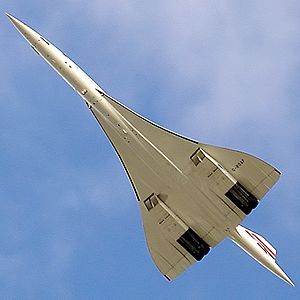
In the 20th century, Bristol became a major centre for aircraft production. The Bristol Aeroplane Company made famous planes like the Bristol Fighter and the Blenheim. They also made civilian planes like the Bristol Freighter.
Filton played a key role in building the Concorde supersonic airliner. The British Concorde prototype made its first flight from Filton in 1969. In 2003, the last Concorde flight landed back at Bristol Filton Airport. It is now the main attraction for a planned air museum.
Today, the aerospace industry is still very important in Bristol. Big companies like BAE Systems, Airbus, and Rolls-Royce are based here. Bristol is also home to Cameron Balloons, which makes hot air balloons. Every August, Bristol hosts the Bristol International Balloon Fiesta, one of Europe's biggest hot-air balloon events.
Bristol's Culture
Arts and Entertainment
Bristol has a lively arts scene. In 2008, the city was a finalist for the European Capital of Culture. In 2017, UNESCO named it a "City of Film."
The Bristol Old Vic theatre is very old. It opened in 1766 and is the oldest theatre in England that has been open continuously. The Bristol Hippodrome is a larger theatre for touring shows. There are also many smaller theatres.
Bristol has lots of places for live music. The largest is the 2,000-seat Bristol Beacon. Other popular venues include the Bristol Academy and The Fleece. In 2010, Bristol was called the UK's most musical city.
The city is famous for its "trip hop" and "Bristol Sound" music, with artists like Tricky, Portishead, and Massive Attack. It's also a big place for drum and bass music. The The Downs Festival is a major yearly music event.

The Bristol Museum and Art Gallery has collections of natural history, archaeology, and art. The M Shed museum opened in 2011 on the site of the old industrial museum.
The famous graffiti artist Banksy is thought to be from Bristol. Many of his works can be seen around the city. Aardman Animations, which makes stop-motion films like Wallace and Gromit and Chicken Run, is based in Bristol.
Bristol is also home to the BBC Natural History Unit, which makes amazing wildlife documentaries like Planet Earth. Famous actors like Cary Grant and comedians like Russell Howard were born in Bristol.
Buildings and Styles
Bristol has many historic buildings, with over 3,800 listed as important. You can see many different styles of architecture from medieval times to modern day. In the mid-19th century, a unique style called "Bristol Byzantine" was developed here.
The oldest important buildings are churches. St James' Priory was founded in 1129. Bristol Cathedral was founded in 1140. St Mary Redcliffe church, built in the 12th century, is the tallest building in Bristol. Queen Elizabeth I called it "the fairest, goodliest, and most famous parish church in England."
Other old buildings include The Red Lodge, built in 1580, and St Bartholomew's Hospital from the 12th century. Many old pubs, like the Llandoger Trow and the Hatchet Inn, were built in the 17th century.
During World War II, many parts of Bristol city centre were bombed. But even after that, in 1961, writer John Betjeman called Bristol "the most beautiful, interesting and distinguished city in England."
Sports in Bristol
Bristol has professional teams in many major sports.
Football
Bristol has two main football clubs: Bristol City and Bristol Rovers. Bristol City was formed in 1894. They play at Ashton Gate Stadium. Bristol Rovers, formed in 1883, are the city's oldest professional football team. They play at the Memorial Stadium. Bristol City Women also play at Ashton Gate.
Rugby
Bristol Bears is the city's professional rugby union team, formed in 1888. They also play at Ashton Gate Stadium. There are many smaller rugby clubs in Bristol too. The Bristol Sonics represent rugby league.
Cricket
Gloucestershire County Cricket Club plays most of its home games at the Bristol County Ground. This is the only major international sports venue in the south-west of England. The club has won many trophies, especially in one-day cricket.
Other Sports
The Bristol Flyers basketball team plays in the top UK professional league. The Bristol Aztecs play American football. Ice hockey also returned to Bristol with the Bristol Pitbulls.
Bristol hosts an annual half marathon. The city was also used as a training camp for the 2012 London Olympics. The Bristol International Balloon Fiesta is a huge hot-air balloon event held every summer.
Bristolian Dialect
Long-time residents of Bristol speak a special dialect of English called Bristolian. People from Bristol are called Bristolians. This dialect has a "rhotic accent," meaning they pronounce the "r" sound in words like "car."
A unique part of the Bristolian accent is the "Bristol (or terminal) l." This is where an "l" sound is added to words ending in "a" or "o." For example, "area" might sound like "areal" or "areaw." The way "Bristol" is pronounced is an example of this.
Religions in Bristol
In the 2011 census, 46.8% of people in Bristol said they were Christian. A large number, 37.4%, said they had no religion. Islam is followed by 5.1% of the population. Other religions like Buddhism, Hinduism, and Sikhism are also present.
Bristol has many Christian churches, including the Anglican Bristol Cathedral and St Mary Redcliffe. There are also eleven mosques, several Buddhist centres, a Hindu temple, synagogues, and Sikh temples.
Nightlife and Fun
Bristol has a lively nightlife. It has been given "Purple Flag" status for many areas, which means they are safe and well-managed at night.
DJ Mag ranked Motion as one of the best clubs in the world. Motion used to be a skate park but is now a popular place for music and dancing. Other famous clubs include Lakota and Thekla. The Attic Bar and Full Moon Pub are also popular spots. The Apple is known as one of the best cider bars in the UK.
Media in Bristol
Bristol is home to the regional offices of BBC West. It also has the famous BBC Natural History Unit, which makes amazing TV shows about nature and wildlife. These include shows by David Attenborough like Life on Earth and Planet Earth.
Bristol has two daily newspapers, the Western Daily Press and the Bristol Post. There is also a free newspaper called Metro. The Bristol Cable does investigative journalism.
Aardman Animations, the studio behind Wallace and Gromit, is based in Bristol. Local radio stations include BBC Radio Bristol and Heart West. TV shows like Deal or No Deal and The Crystal Maze have also been made in Bristol. In 2018, Channel 4 chose Bristol as one of its new "Creative Hubs."
Learning in Bristol
Bristol has two main universities: the University of Bristol and the University of the West of England. There are also colleges for further education and theological colleges.
The city has many schools, including 129 primary schools and 17 secondary schools. Bristol also has a high number of private schools, such as Clifton College and Bristol Grammar School. The Redmaids' School, founded in 1634, claims to be England's oldest girls' school.
In 2005, Bristol was named one of England's six "science cities." Research is done at the universities and hospitals. Places like We The Curious and the Bristol Zoo help teach people about science.
Many famous scientists have come from Bristol. These include chemist Humphry Davy and physicist Paul Dirac, who won a Nobel Prize. Colin Pillinger was a planetary scientist known for the Beagle 2 project.
Getting Around Bristol
Trains
Bristol has two main train stations. Bristol Temple Meads is near the city centre. It has fast trains to London and local services. Bristol Parkway is north of the city and also has fast trains to London, Cardiff, and other major cities.
There are plans to improve Bristol's train network, including reopening a line to Portishead.
Roads
Major motorways connect Bristol to other parts of the UK. The M4 motorway goes east to London and west to Wales. The M5 motorway goes north to Birmingham and south to Exeter. The M32 connects the M4 to the city centre.
Bristol is working on a Clean Air Zone to reduce pollution. This might mean charging older, more polluting vehicles to enter the city centre. Traffic can be heavy in Bristol because many people use private cars.
Buses and Water Taxis
The main public transport in Bristol is the bus network, run by First West of England. There are also other bus companies.
The city council has thought about building a light rail system, but it hasn't happened yet. However, a bus rapid transit system called MetroBus started in 2018. It aims to provide faster bus services.
You can also travel by boat in the city centre. Bristol Ferry Boats and other companies offer trips in the Floating Harbour.
Cycling
Bristol was named England's first "cycling city" in 2008. It is home to Sustrans, a charity that promotes sustainable transport. The Bristol and Bath Railway Path is a popular cycle route that links Bristol to Bath. Cycling has become much more popular in the city.
Air Travel
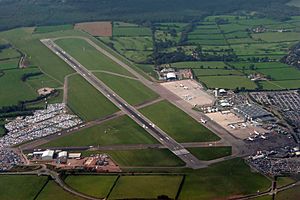
Bristol Airport is located just outside the city. In 2023, it was the eighth busiest airport in the UK, handling nearly 10 million passengers.
Bristol's International Friends
Bristol was one of the first cities to start "town twinning" after World War II. This means it has special friendly links with cities around the world. Its twin towns include:
- Bordeaux, France (since 1947)
- Hanover, Germany (since 1947)
- Porto, Portugal (since 1984)
- Tbilisi, Georgia (since 1988)
- Puerto Morazán, Nicaragua (since 1989)
- Beira, Mozambique (since 1990)
- Guangzhou, China (since 2001)
Famous Bristolians
Some people and groups have been given the "Freedom of the City" of Bristol. This is a special honour. They include:
- Billy Hughes: 1916
- Kipchoge Keino: 2012
- Peter Higgs: 2013
- Sir David Attenborough: 2013
- The Rifles: 2007, 2015
- 39 Signal Regiment: 2019
Images for kids
-
Avon Gorge and Clifton Suspension Bridge, looking towards Bristol.
-
Site of the former Bristol Industrial Museum, now the M Shed.
-
The Memorial Stadium, home of Bristol Rovers.
See also
 In Spanish: Bristol para niños
In Spanish: Bristol para niños


